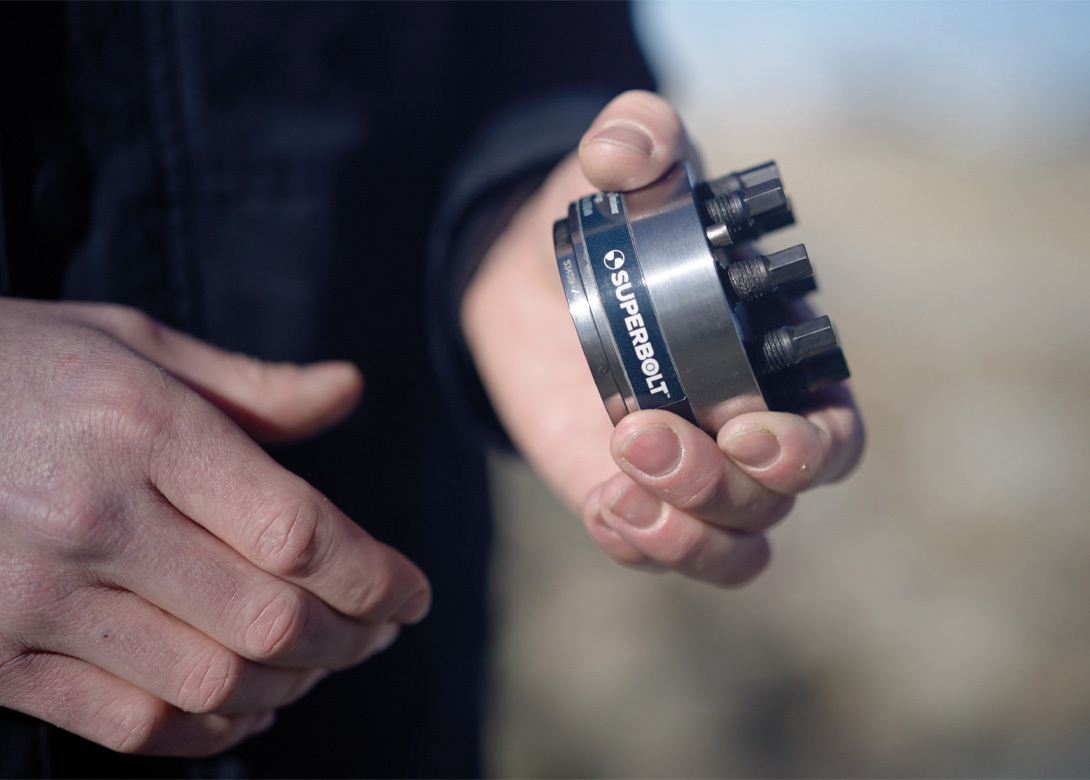
Secure bolted joints are critical for the operation and safety of infrastructure, but ensuring such joints are tightened, and stay tightened, to the correct preload can be a challenging task.
As wind turbines get bigger, operating in increasingly harsh environments, or on floating platforms, bolted connections are reaching their capacity limits and are often complex to design, install and maintain. Traditional methods for monitoring preload, such as using torque wrenches, or ultrasonic measurement, can be time consuming and inaccurate.
Now, with advances in Nord-Lock Group’s SMART technologies, it’s possible to install sensors on the joint and monitor preload remotely, transmitting data via the Cloud and reading it from a smartphone or computer dashboard. Total control of preload on MP-TP flange connections can be achieved in this way.
Nord-Lock’s Superbolt LST (Load Sensing Tensioner) is based on the well known Superbolt Multi-Jackbolt Tensioner (MJT), with strain gauges installed around the lower section of the nut body to measure its expansion as preload increases, or decreases.
Companies interested in remote preload monitoring don’t need additional skill or specialist knowledge to use the products. The ‘plug and play’ systems can be used by an operator with a handheld device to read out preload during installation/maintenance checks, then left installed to transmit data during the lifetime of the application. Using a wind turbine’s Wi-Fi, or radio networks via sim cards, preload data can be monitored from a laptop, or mobile screen, anywhere in the world.
As for how to use preload data gathered by Superbolt LST/LSF, one key advantage is that Nord-Lock Group’s SMART solutions can collect and store large amounts of data, which can be analysed to detect patterns and trends. By remote monitoring, live preload updates can be received at intervals defined by the user – as frequently as 100 times per second – which is especially useful for turbines located in remote, or difficult to reach, locations. Preload can be monitored in ‘real time’, on screen.
By using the data to understand changes in preload over time, predictive maintenance opportunities also arise where a potential failure can be identified and alerts sent to the maintenance team before it’s too late. In addition, automatic alerts/notifications can be set so if preload falls outside pre-defined ranges, maintenance teams can act to prevent damage. There’s also the opportunity for historical analysis of sea level data, wind speeds and other weather conditions, where saved preload data can be viewed to troubleshoot past maintenance incidents/discoveries. Finally, R&D can use preload data gathered by Superbolt LST/LSF, along with weather conditions, to help with planning future windfarm developments or innovating newer turbine designs.
As for where to monitor preload, there are few restrictions and Superbolt LST/LSF can be used on most bolted connections inside the turbine. They’re commonly applied to flange connections in the MP-TP connection, given the increasingly large forces to which tower bolts are subjected, as well as on blade-to-hub bolts, yaw bearings and anchor bolts.
More generally, this kind of IoT-based remote preload monitoring can be used in any industry where the use of bolted joints is critical for the operation and safety of equipment. There is huge potential for this in other power generation industries, as well as oil and gas, construction, rail infrastructure, manufacturing and mining, to name a few.
Superbolt LST/LSF advantages
When it comes to some of the advantages of using Nord-Lock Group’s Superbolt LST/LSF, these include accuracy, for one, where torque checks tell if a bolt is loose or not. SMART solutions give accurate preload values within a range of ±5% (Superbolt LST). The solution is also secure, based on Multi-Jackbolt Tensioners (MJTs), which were originally invented by Superbolt in 1984, bolted joints can, as a result, be accurately tightened without specialised skills or heavy tooling. The company also emphasises the
cost-effectiveness of using Superbolt LST and LSF, which can be spaced periodically around a critical flange connection, for example, giving a reliable, updated view on the long-term structural integrity of infrastructure. This means planning more efficient maintenance schedules can be conducted – prevention being ‘cheaper’ than cure.
The solution will also be profitable by extending the lifecycle of windfarm operations, with reliable structural monitoring. Another advantage of SMART technologies is scalability, as they can be tested by customers in partnership with expert engineers to prove the concept in their own applications, which can then be scaled up. Other advantages of Nord-Lock Group’s SMART products include being essentially ‘plug and play’, with the LST and LSF ‘at work’ continuously and dynamically, monitoring loads to avoid bolt fatigue and fracturing. Last but not least, while most monitoring and measuring methods are invasive, Superbolt LST is not, and leaves the bolted connection as it is, without destroying or altering anything.
In conclusion, using remote preload monitoring systems can expand the possibilities of structural maintenance and infrastructure design, with Nord-Lock Group’s SMART solutions today actively supporting the wind industry to improve safety; plan more efficient maintenance; and improve the overall performance of turbines. These principles and the company’s experience are applicable in industries, worldwide.

Will joined Fastener + Fixing Magazine in 2007 and over the last 12 years has experienced every facet of the fastener sector – interviewing key figures within the industry and visiting leading companies and exhibitions around the globe. Will manages the content strategy across all platforms and is the guardian for the high editorial standards that the brand is renowned.





